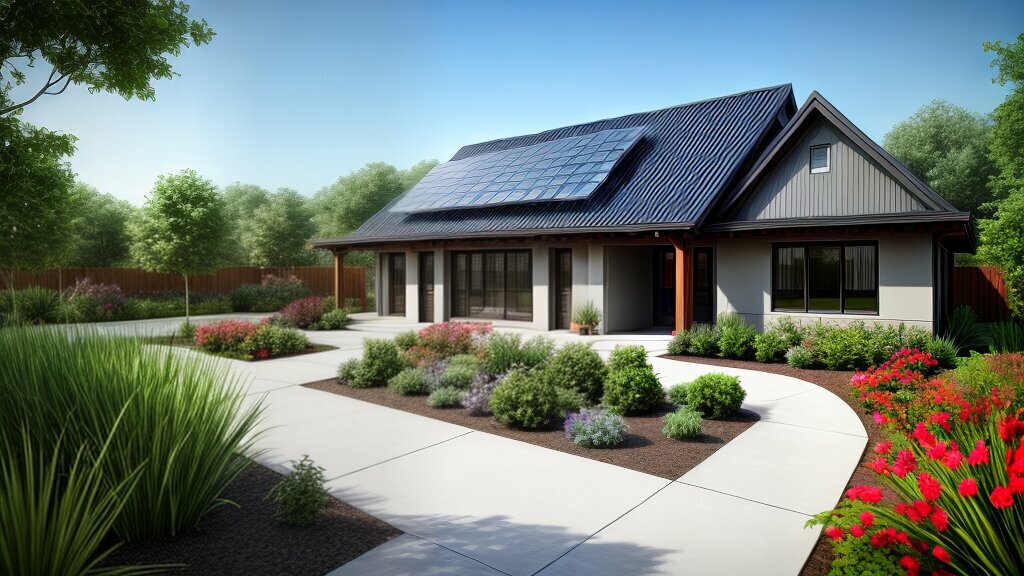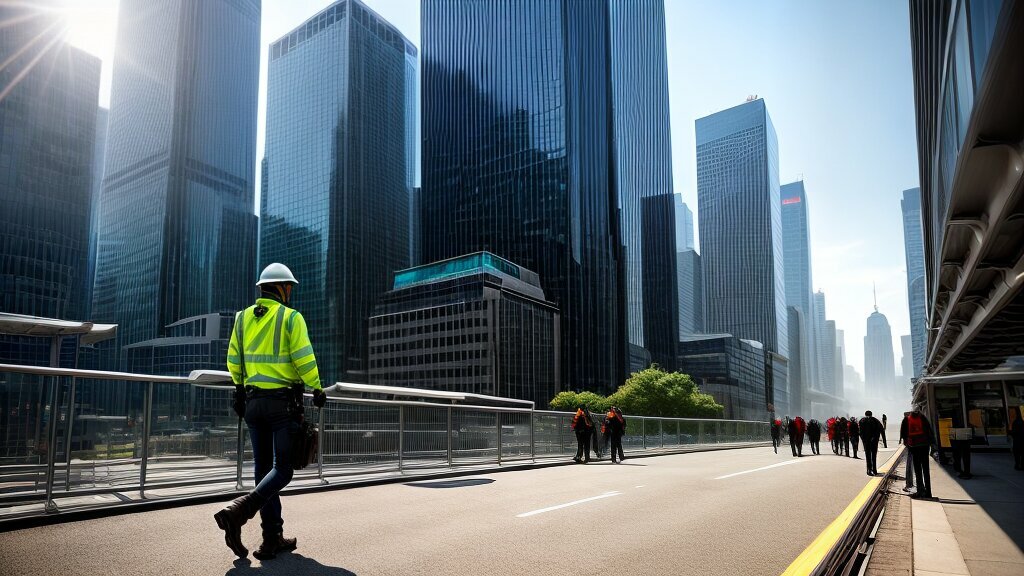Welcome to our article on carbon-neutral construction materials, where we’ll explore the importance of sustainable building practices and the role of eco-friendly materials in reducing our carbon footprint. The construction industry is a significant contributor to greenhouse gas emissions, and carbon-neutral construction materials provide a solution to mitigate these impacts. In this article, we’ll delve into the breakthroughs and potential of carbon-neutral construction materials, as well as their types, advantages, limitations, innovations and future trends. We’ll also showcase successful implementations of such materials and discuss the policies and regulations in place to promote their use. Join us on this journey to discover the exciting world of sustainable building materials.
Key Takeaways:
- Carbon-neutral construction materials are essential in creating a sustainable future for the building industry.
- The construction industry is a significant contributor to greenhouse gas emissions.
- Certain breakthroughs and potential of carbon-neutral construction materials provide a solution to mitigate these impacts.
Understanding Carbon-Neutral Construction Materials
Carbon-neutral construction materials are those that have a low carbon footprint, meaning they produce little or no greenhouse gas emissions during their production, transportation, and use. These materials play a key role in creating sustainable building practices and reducing the negative impact of the construction industry on the environment.
The use of carbon-neutral materials such as green construction materials and sustainable construction products can significantly reduce greenhouse gas emissions. Green construction materials are those that have been recycled or are made from renewable sources, while sustainable construction products refer to those that are environmentally friendly and contribute to energy efficiency and indoor air quality.
Carbon-neutral construction materials have a number of benefits, including reducing dependence on fossil fuels, promoting sustainable forestry practices, and improving the health and well-being of building occupants. By using low carbon footprint materials, the construction industry can help mitigate climate change while improving the overall sustainability of buildings.

Types of Carbon-Neutral Construction Materials
Carbon-neutral construction materials come in different types, each offering unique benefits and applications. Here are some of the most common types:
| Type |
Description |
| Bamboo |
Bamboo is a fast-growing grass that is a highly renewable resource. It is durable and has a high strength-to-weight ratio, making it ideal for building structures. |
| Recycled Steel |
Recycled steel is made from scrap metal, reducing the amount of waste and energy required to produce new steel. It has high strength and durability and can be used in a variety of applications. |
| Earth |
Earth is a natural and sustainable material that has been used for centuries in construction. It has excellent thermal properties, making it ideal for building passive solar homes. |
| Hempcrete |
Hempcrete is a mixture of hemp fibres and lime, making it a lightweight and durable material. It has excellent insulation properties and is breathable, making it ideal for healthy indoor air quality. |
Other carbon-neutral construction materials include recycled plastic, mycelium, and cross-laminated timber. These materials offer a wide range of benefits, including reduced carbon footprint, improved energy efficiency, and healthier indoor environments.
Image description: A bamboo forest with bright green leaves. The image shows how bamboo is a highly renewable resource that can be used in construction.

Advantages of Carbon-Neutral Construction Materials
Using carbon-neutral construction materials can have significant advantages in building projects. Sustainable construction products not only reduce the carbon footprint of the building industry but also offer other benefits.
| Advantages of Carbon-Neutral Construction Materials |
Description |
| Energy Efficiency |
Green construction materials are designed to provide effective insulation, reducing energy consumption and bills. Using low carbon footprint materials can also help to regulate indoor temperature, improving comfort levels. |
| Improved Indoor Air Quality |
Eco-friendly construction materials are typically free from toxic chemicals and volatile organic compounds (VOCs), improving air quality. This can have benefits for the health and wellbeing of building occupants. |
| Longevity and Durability |
Many sustainable building materials are more durable than traditional materials, offering a longer lifespan and reducing the need for frequent replacements. This can also result in cost savings over time. |
| Zero-Emission |
The use of zero-emission construction materials can help to mitigate climate change by reducing greenhouse gas emissions. This has benefits for the environment and can contribute to a more sustainable future. |
Overall, the use of carbon-neutral construction materials has a positive impact on both the environment and building occupants. Incorporating sustainable building materials into construction projects can result in significant benefits and cost savings over time.

Innovations in Carbon-Neutral Construction Materials
The push towards sustainable building practices has paved the way for a wave of innovative solutions in carbon-neutral construction materials. From cutting-edge technologies to new materials, these innovations are poised to transform the industry.
One noteworthy innovation is the development of engineered wood products. These products, such as cross-laminated timber (CLT) and laminated veneer lumber (LVL), are made from renewable wood sources and have a much lower carbon footprint than traditional steel and concrete building materials. In fact, CLT has been found to have a negative carbon footprint, meaning it absorbs more carbon dioxide than it emits during its production and use.
Another emerging trend is the use of mycelium-based materials. Mycelium, the vegetative part of a fungus, can be grown into a strong, lightweight material that can replace traditional insulation and packaging materials. Not only is mycelium renewable and biodegradable, but it also has the potential to sequester carbon dioxide during its growth process.
The use of 3D printing technology is also gaining traction in the construction industry. This technology allows for the precise and efficient production of building components, reducing waste and energy consumption. Additionally, 3D printing can be used with sustainable materials such as bioplastics, reducing the overall carbon footprint of the construction process.
Robotics and automation are also being utilized to create more efficient and sustainable construction practices. Drones, for example, can be used to inspect and survey building sites, while autonomous heavy machinery can reduce the carbon emissions associated with traditional construction methods.

Overall, the future of carbon-neutral construction materials looks bright, with ongoing research and development leading to new and innovative solutions.
Challenges and Limitations of Carbon-Neutral Construction Materials
Despite their potential benefits, carbon-neutral construction materials still face several challenges and limitations that hinder their widespread adoption.
One major limitation is the cost of these materials. Traditional building materials, such as concrete and steel, are often cheaper than sustainable alternatives. This means that builders may be reluctant to invest in carbon-neutral materials, especially for large-scale projects.
Another challenge is the availability of these materials. Some sustainable materials, such as bamboo and straw, may not be readily available in certain regions or may not be suitable for certain types of construction.
Scalability is also a challenge. Many carbon-neutral construction materials are still in the experimental phase, and their manufacturing and distribution processes may not be able to handle large-scale demand.
Furthermore, there may also be concerns over the durability and safety of these materials. Builders may be hesitant to use unfamiliar or untested materials, especially if they are less resistant to fire or water damage.
Despite these challenges, there are ways to overcome them and encourage the adoption of carbon-neutral construction materials. Governments can provide incentives and subsidies for builders who use sustainable materials, while researchers and manufacturers can work to improve the cost-effectiveness and scalability of these materials.
By addressing these limitations, carbon-neutral construction materials can play a critical role in reducing the carbon footprint of the building industry and creating a more sustainable future.

Case Studies: Successful Implementation of Carbon-Neutral Construction Materials
Real-world projects have demonstrated the effectiveness of carbon-neutral construction materials in creating sustainable and eco-friendly buildings. Let’s take a look at some successful case studies:
| Project Name |
Location |
Materials Used |
Outcome |
| One Central Park |
Sydney, Australia |
Green walls, photovoltaic panels, recycled water systems |
Reduction of greenhouse gas emissions by 1,180 tons per year |
| The Edge |
Amsterdam, Netherlands |
Smart lighting, solar panels, geothermal heating and cooling systems |
Certified as the greenest office building in the world in 2016 |
| Bank of America Tower |
New York City, USA |
Daylight harvesting, high-performance insulation, water-efficient fixtures |
Achieved LEED Platinum certification, the highest level of green building certification |
These projects demonstrate the feasibility of using carbon-neutral construction materials and their ability to achieve impressive results in terms of reducing greenhouse gas emissions and achieving green building certifications. As more case studies emerge, we can expect to see widespread adoption of sustainable building practices.

Image source: seowriting.ai
Future Trends and Opportunities in Carbon-Neutral Construction Materials
As the demand for sustainable building practices increases, the development of carbon-neutral construction materials is rapidly advancing. Emerging technologies and trends are showing promising results, and the potential for renewable and climate-friendly construction materials is immense.
One trend gaining traction is the use of bioplastics in construction. Derived from biological sources, bioplastics have a lower carbon footprint than traditional plastics, making them an attractive option for building materials. Researchers are working to create bioplastics that can replace concrete, one of the most widely used construction materials.
Another trend is the use of nanotechnology to create stronger and more durable materials. Nanoparticles can enhance the performance of building materials, making them more resistant to wear and tear, and increasing their lifespan. This technology has the potential to reduce the need for frequent repairs and replacements, lowering the environmental impact of the building industry.
Additionally, the development of carbon-negative materials is gaining attention. These materials absorb more carbon dioxide than they emit during their production and use, making them a valuable tool in the fight against climate change. (https://www.colburnschool.edu/) One example is timber, which stores carbon throughout its life cycle and can be used as a substitute for energy-intensive materials like concrete and steel.

These trends, along with other technological advancements, have the potential to revolutionize the construction industry. However, their widespread adoption faces challenges such as scalability and cost-effectiveness. Research and development efforts must focus on overcoming these obstacles to make renewable and climate-friendly construction materials a practical and cost-effective choice for builders and developers.
Looking Ahead
As the world faces increasing environmental challenges, the importance of sustainable building practices cannot be overstated. The future of the construction industry lies in the development and adoption of carbon-neutral construction materials. With innovative research and development efforts, the potential for a sustainable future is closer than ever.
Policies and Regulations Promoting the Use of Carbon-Neutral Construction Materials
The building industry has a vital role to play in reducing global greenhouse gas emissions and mitigating the impact of climate change. Governments and regulatory bodies worldwide are increasingly recognizing the importance of promoting the use of carbon-neutral construction materials to achieve sustainability targets.
Many countries have introduced policies and regulations to encourage the adoption of sustainable building materials and eco-friendly construction practices. In the UK, for instance, Building Regulations require new buildings to meet minimum energy efficiency standards, and the government has set a target for net-zero greenhouse gas emissions by 2050.
Certifications such as the Leadership in Energy and Environmental Design (LEED) and the Building Research Establishment Environmental Assessment Method (BREEAM) provide standards for sustainable building materials and encourage their use in construction projects. Such certifications evaluate a building’s environmental impact, including emissions, water usage, and waste management.
Regulatory frameworks are essential in driving industry-wide change and promoting the adoption of carbon-neutral construction materials. However, the availability, cost, and scalability of such materials can still present challenges and limitations.
As such, there is a need for further research and development of carbon-neutral construction materials to overcome these limitations. The building industry must continue to innovate and collaborate to create sustainable building solutions that have a positive impact on the environment and society.

Conclusion
In conclusion, carbon-neutral construction materials are crucial in creating a sustainable future for the building industry. The breakthroughs and potential of such materials in reducing the carbon footprint of the industry cannot be overlooked. Understanding the key characteristics of carbon-neutral construction materials, including their low carbon footprint and eco-friendliness, is paramount in driving their adoption.
Despite the challenges and limitations associated with their use, the advantages of carbon-neutral construction materials cannot be ignored. Sustainable construction products and zero-emission construction materials have the potential to significantly mitigate the effects of climate change and promote energy efficiency.
The latest innovations in carbon-neutral construction materials provide an exciting glimpse into the future of sustainable building practices. Renewable construction materials and climate-friendly construction materials are poised to revolutionize the industry and drive sustainable development.
Furthermore, policies and regulations that promote the use of sustainable building materials and eco-friendly construction materials must be supported. Government initiatives, as well as industry standards and certifications, have a crucial role in driving industry-wide change.
Looking Forward
As we move towards a sustainable future, the use of carbon-neutral construction materials will play a significant role in mitigating the impact of the building industry on the environment. It is essential that we continue to research and adopt these materials, drive innovation and investment in their development, and encourage their widespread adoption. By doing so, we can create a greener, more sustainable planet for generations to come.
FAQ
Q: What are carbon-neutral construction materials?
A: Carbon-neutral construction materials are materials that have a low carbon footprint and do not contribute to greenhouse gas emissions. These materials are designed to reduce the environmental impact of the building industry and promote sustainability.
Q: Why are carbon-neutral construction materials important?
A: Carbon-neutral construction materials are important because they help to reduce the carbon footprint of the building industry. By using these materials, we can significantly decrease greenhouse gas emissions and mitigate climate change. Additionally, these materials promote sustainable building practices and contribute to a healthier environment.
Q: What are the benefits of using carbon-neutral construction materials?
A: Using carbon-neutral construction materials has several benefits. They help to reduce energy consumption, improve indoor air quality, and promote sustainable development. Additionally, these materials can contribute to a more resilient and environmentally friendly built environment.
Q: What types of carbon-neutral construction materials are available?
A: There are various types of carbon-neutral construction materials available, including renewable materials such as bamboo and timber, recycled materials like recycled concrete and steel, and eco-friendly materials such as insulation made from natural fibers. These materials offer sustainable alternatives to traditional construction materials.
Q: What are the challenges and limitations associated with carbon-neutral construction materials?
A: Some challenges and limitations of carbon-neutral construction materials include their higher cost compared to traditional materials, limited availability in certain regions, and scalability issues. However, ongoing research and innovation are addressing these challenges and making these materials more accessible and cost-effective.
Q: Can you provide examples of successful implementation of carbon-neutral construction materials?
A: Yes, there have been several successful case studies where carbon-neutral construction materials have been implemented. For example, the Bullitt Center in Seattle is a certified Living Building that showcases sustainable building materials and techniques. Another example is the CopenHill waste-to-energy plant in Copenhagen, where the building’s facade is covered in solar panels.
Q: What are the future trends and opportunities in carbon-neutral construction materials?
A: The future of carbon-neutral construction materials is promising. Emerging technologies such as 3D printing and advanced insulation materials offer exciting opportunities for sustainable building practices. Additionally, the increasing focus on renewable energy and climate-friendly construction materials will drive further innovation in this field.
Q: Are there policies and regulations promoting the use of carbon-neutral construction materials?
A: Yes, there are policies and regulations in place to promote the use of carbon-neutral construction materials. Governments and organizations around the world are implementing initiatives, certifications, and standards to encourage the adoption of sustainable building materials. These regulatory frameworks play a crucial role in driving industry-wide change.


























Post comments (0)